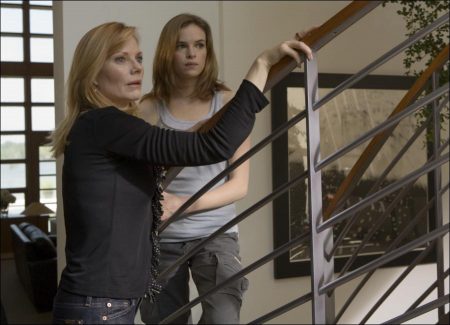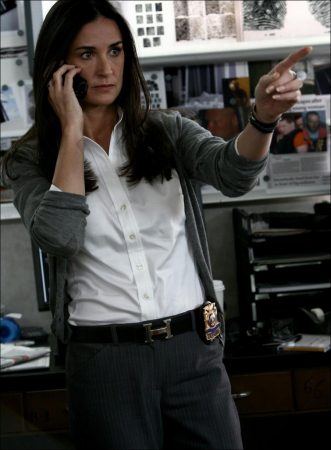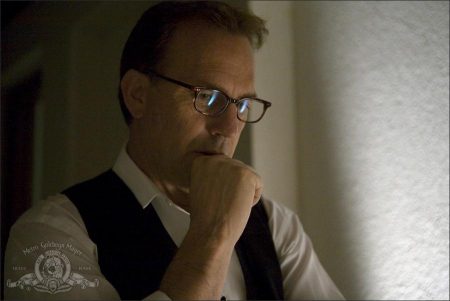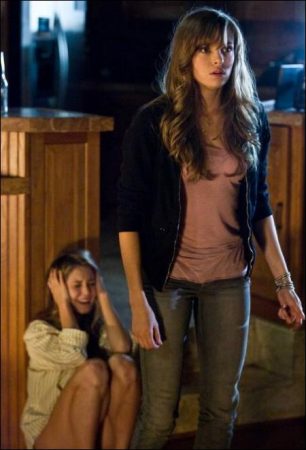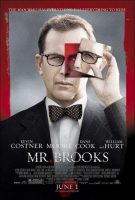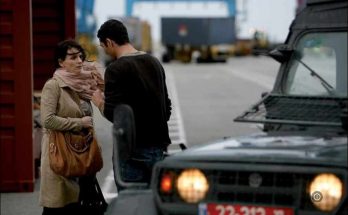Mr. Brooks Movie Trailer. Ultimately, Evans knew that the key to making the film would lie in finding an exceptionally talented cast willing to “dip their toes into some rather eerie waters.” Says Raynold Gideon: “All of these talented actors came along, took our blueprint and created a cathedral.” There were many reasons that Bruce Evans and Raynold Gideon imagined Kevin Costner as MR. BROOKS from the start.
First and foremost was the chance to subvert his charm, looks and reputation, as an unassailable screen hero in a way they knew would ratchet up the tension in their thriller. But it was also an opportunity to showcase, in an unexpected way, the acting skills that Costner has demonstrated in such diverse roles as the Civil War Lieutenant who befriends a Sioux tribe in “Dances With Wolves”; the hardened kidnapper who connects with his young captor in Clint Eastwood’s “A Perfect World”; the iconic title hero of Lawrence Kasdan’s “Wyatt Earp”; the once-great baseball star who falls for an embittered woman in Mike Binder’s “The Upside of Anger” and most recently, the aging Coast Guard rescue swimmer facing his legacy in Andrew Davis’ “The Guardian.”
“I’ve always thought of Kevin as someone very capable of surprising audiences,” says Evans, “and I don’t think he’s gotten enough credit yet for what a skilled actor he is. But, as a former actor myself, I know how hard what he does is. He doesn’t hide behind tics or mannerisms and or large brush-strokes. He is much more subtle than that – which is where his power to really take a role like this and run with it comes in.”
Costner fearlessly dove into the role from the moment he committed to it. Says co-writer and producer Gideon: “Kevin set the bar very high from the first day of rehearsal. His understanding of Earl Brooks really drove the creation of the entire film. Mr. Brooks is a very flawed human being and his crimes are shocking, but he also knows what he is doing is wrong, and the way Kevin brings that internal struggle to the fore is what makes him so fascinating.”
First and foremost, Costner did not want to whitewash the stark truth of who Mr. Brooks is — a man who fights his inner demons yet returns again and again to the compulsion to kill. Nor could he forget the havoc and heartbreak the character wreaks with his brilliantly planned but gruesomely cruel murders of total strangers. States Costner: “Make no mistake, the places Mr. Brooks goes are indefensible and despicable, but what makes him so interesting is that he has this other pressure on him that you don’t usually get to see in a killer – there’s a conscience beating at him.”
Costner was profoundly horrified at times by the thoughts and deeds of Mr. Brooks, but that’s also what made this role such an irresistible and intense challenge as an actor. “For the part of Brooks that is most depraved, I really had to use my imagination,” the actor comments. “There was no other way to understand that kind of drive to kill other people. But when he’s conducting his business or taking care of his family or even trying to understand himself, I could relate in some way to those things, and I tried to humanize those moments.”
Indeed, for Costner, the only way in to Earl Brooks’ savage soul was through the only two things he really cares about: his family and the company he built, neither of which he wants to lose now that he is under the unthinkable threat of getting caught by a tenacious detective. “There’s something very genuine about that side of him that is truly in love with his wife, his daughter, his house and his business – but you never can forget that is also what allows him to be the successful killer that he is,” he says.
As for why Mr. Brooks’ family don’t see, or perhaps don’t want to see, the demons lurking inside him, Costner believes that human nature often allows us to deny the darkness in other people – and that Mr. Brooks takes full advantage of this with his loved ones. “How often do you see someone confronted on TV after a murder, the wife or mother who says: ‘He couldn’t have done that. I never saw that side of him’?” That’s why it’s not that far of a stretch to believe someone like Mr. Brooks could get away with these terrible murders. He’s a very precise guy and he keeps his life perfectly compartmentalized,” explains Costner. “He’s always found a way to maintain that. But now, a Pandora’s box is about to open with his daughter and other situations he never could have seen coming.”
In producer Jim Wilson’s eyes it’s precisely the very human qualities which Kevin Costner brings to this monster of a man that makes the character one of the of most chilling serial killers yet seen on screen – one who digs deep into our worst fears about what the most charming and alluring people we know around us might be hiding.
“Here you have this dashing, charismatic man in Kevin Costner, but you start to peel away his layers and realize that he has a terrible, unstoppable addiction to killing,” sums up Wilson. “In Kevin’s performance, with every single scene there’s another layer of Mr. Brooks that we see. I think it’s as complicated and multi-layered a character as he has ever played. “
A Cop as Obsessive as the Killer She’s Chasing
In the wake of his latest horrific crime – this time the murder of two lovers in the throes of passion — Mr. Brooks faces a nemesis almost as savvy as he is: the tough-minded Detective Atwood. She pours herself into finding the serial killer because, on the heels of a brutal divorce, she herself has nothing else left. The two characters become as mirrors to one another: the amoral criminal and his impassioned chaser, each seeking to be free of their demons and start anew.
“What I love about Detective Atwood is that she is really the motor of the movie and you rarely see a woman in this role as the chaser of a killer,” says Bruce Evans. “To have Demi Moore take on this role of a cop who is just as smart as the brilliant murderer she is after was a thrill. She formed such a bond with Kevin and Dane Cook and they really brought so much more to their characters than I could ever have imagined.”
Moore’s recent films have taken her in diverse directions, ranging from the ensemble drama “Bobby” to the action of “Charlie’s Angels 2: Full Throttle.” She first heard about MR. BROOKS directly from Kevin Costner when Ashton Kutcher was working with him on “The Guardian.” “Kevin was always talking about MR. BROOKS, about how he was going to play a serial killer and he was really trying to explore who this guy was. Even then, there was something very dynamic about his enthusiasm for it that really struck me,” Moore recalls.
It wasn’t until months later that the filmmakers approached Moore formally and sent her a script. “When I read it, I immediately understood Kevin’s passion for the material,” she continues. “The script exhilarated me and frightened me at the same time. I thought it was very smart and filled with characters who have depth.”
Like everyone who encounters the character of Mr. Brooks, Moore found him very provocative. “I think he sort of embodies our greatest fear – that the normal person in front of you could actually have bodies in the basement,” she says. “The way Kevin plays him he’s so likeable and relatable – he’s a father, a husband, a friend — but look at what he’s really out there doing in the world.”
Moore was equally drawn to Detective Atwood – in part because the character is so counter to her own personality. “There was something very attractive to me about how volatile and impulsive she is,” says the actress. “The rage Atwood has is something that I personally don’t like, which made it very exciting to have to tackle her. I’m more of a person who is comfortable being sedate and being in control of my emotions. So I felt the role brought up a level of fear in me that was good. It was that fear of who she is and how she is in the world that really made me want do it.”
As she began to explore Atwood further, Moore began to see her as someone who has just about reached emotional rock bottom – and, in that way, is not all that different from the murderer she is hunting. “She’s really someone whose life is a complete disaster on every level so her only savior is work. She has all this pent-up frustration and her fuse is very short but I think that all of this volatility is really a sign of somebody who’s in pain,” she continues. “It’s an interesting parallel with Mr. Brooks. They’re both dealing with a lot of pain, but they find opposite outlets for it. It’s intriguing that what separates the cop from the criminal psychologically can be a very fine line.”
Another unexpected element that attracted Moore was how the film’s dark themes are laced with sudden flashes of humor. “One of the beautiful things in the writing of this movie is that there is a lot wit and irony and nothing is approached as black and white,” she says.
In preparing for the role, Moore admits she had an unusual jump-start. “I’m an avid watcher of shows like ‘Forensic Files’ and ‘The Investigators’ and truly hold a fascination for the arts of deduction. It’s really one of my guilty pleasures,” she admits. “I’m intrigued by this kind of work – by the combination of the physical aspects as well as the intellect and intuition, and of course, the science of breaking down the details.”
Moore had already studied various elements of forensics and investigation at the FBI Academy in Quantico for a previous film and, even on the set, she was reading case histories of killers for any additional insights. Her authenticity riveted the cast and crew on the set. “We really needed a significant actress who could bring all the strength and angst that go with this character, and Demi really came to our rescue,” sums up Kevin Costner.
The Unwanted Protege
Ironically one of the reasons Demi Moore was initially interested in MR. BROOKS was the chance to work with Costner – yet their characters are usually playing cat-and-mouse. Instead, she mainly interacts with Mr. Brooks’ unexpected new “protégé,” the inept, out-of-his-league blackmailer, Mr. Smith, played with riveting verve by Dane Cook. “Dane was really wonderful,” says Moore. “It was great to see somebody bridge into something that is such unfamiliar territory. He brings some of his comedic qualities to the role and yet it’s not about that.”
Cook, who is one of today’s hottest stand-up comics, was an unexpected choice for such a challenging dramatic role, but it was a choice the filmmakers thought was worth the risk – especially after he sent them a videotape of himself in character. “Dane was definitely a wild card,” says Jim Wilson. “Nobody knew quite what he would do with this character because he’s never done anything even remotely like this. But when we all saw his videotape, it was a revelation. He had simply nailed it. I think people will be very surprised.”
Adds Bruce Evans: “Dane is the real discovery of the movie. He was able to go to the edge of craziness with Mr. Smith in a very exciting way. When Dane showed up on the set I saw this guy coming at me with the jacket and the beard and I thought ‘oh my God, Mr. Smith lives.’ He came ready to work and completely channeled the character.”
Cook doggedly pursued the role because he was ready to break out into something entirely new and different. As the photographer and amateur voyeur who catches Mr. Brooks in the act of murder – and tries to turn it into an opportunity to play out his own most wicked fantasies – Cook knew he would be pushed in ways he wanted to be pushed as an actor.
“I’m interested in breaking out into cinematic roles of every size, shape and form, so this was really a chance for me to start doing that,” Cook says. “When I got the script, it was a definite page-turner. It was one of those things where I was racing to figure out what would happen next.”
Cook was freaked out by Mr. Brooks’ secrets, but also is keenly aware that “anytime you’re in a room full of people you know there’s going to be some who have not just a few skeletons in the closet but a whole barnyard full of them,” he says. “But that’s what is so compelling about Mr. Brooks: you realize this guy could be your buddy. He could be your boss. But, look what he really is underneath the facade.”
Most of all, Cook couldn’t resist the challenges of the ordinary-seeming Mr. Smith, who misguidedly sees Mr. Brooks’ sickness and compulsion to kill as merely a game and an adventure. “As I was reading the lines of Mr. Smith, I found myself already picturing how I would do it,” he recalls. “What excited me about Mr. Smith is that he is unwittingly on a path of total self-destruction. Every move he makes is the wrong step. I’m a guy who likes to constantly keep myself on the right path so it was really interesting for me to play someone who’s so completely off the path.”
Once on the set, as he began interacting with Kevin Costner and Demi Moore, the character deepened even further for Cook. “In stand-up comedy it’s all you, but in a movie like this, you’re part of a storytelling puzzle,” he observes. “It was interesting for me to work collectively with all these incredibly talented people while figuring out where Mr. Smith’s story fits into the overall picture.” He continues: “It was especially great for me to experience Kevin’s passion and creativity. He’s also a very funny dude. Even though we were playing such despicable people, the experience we had together was great.”
The key to Mr. Smith for Cook was getting to the core of why he latches onto Mr. Brooks as a mentor. “I think Mr. Smith accidentally witnessed something and it was like, wait a minute, this might be my calling, this might be who I am. For him, Mr. Brooks is like a hero. He has all the knowledge that Mr. Smith wants,” says Cook. “Mr. Smith sees himself as starting off on this great adventure of becoming a killer. But what he doesn’t foresee, is how he’s going to become a part of Mr. Brooks’ journey.”
Another more practical challenge for Cook was having to act in the same scenes as William Hurt playing Mr. Brooks’ alter-ego, without ever reacting to this figment of the character’s imagination. “It was very unusual because I was in a lot of scenes with Marshall – and yet there isn’t one moment of dialogue between us. It could get kind of eerie,” he notes. “At one point, we were doing one of the scenes where William and Kevin are going back and forth and I’m just looking out the window in my own world. Well, suddenly William leaned up and just brushed lightly against me. But because we’re not supposed to exist in each other’s worlds, just that little touch completely jolted me!”
Mr. Brooks’ Imaginary Friend – Or Is that Friend?
One of the most vital, and unusual, characters in MR. BROOKS is Marshall, Mr. Brooks’ alter ego who exists only in the most shadowy corners of his mind, and reveals the wicked impulses that cause Mr. Brooks to murder strangers.
To play Marshall, the filmmakers knew they would need a truly gifted actor – someone who could make the part feel scary and real while also keeping him within the dream-like realm of a figment of imagination. It was Kevin Costner who first brought up the name of Academy Award winner William Hurt, which whom he had starred in the now-classic “The Big Chill.” “Kevin was adamant that William Hurt would be his perfect alter-ego,” recalls Raynold Gideon.
The reaction among the filmmakers was unanimous. “To have an actor of William Hurt’s caliber take on Marshall was just a thrilling idea,” says Bruce Evans. “When he said ‘yes,’ it brought so much to the film.”
Hurt’s recent work has taken him from the crime kingpin in David Cronenberg’s “A History of Violence” to a founding CIA agent in Robert DeNiro’s “The Good Shepherd,” but Marshall was a role unlike any other – a rare chance to play a psychological demon in the flesh. Hurt was immediately intrigued by Marshall. “He is a pure concoction of Mr. Brooks’ psyche,” he notes. “But I played with the layers of his motivation. Is he simply accommodating Mr. Brooks’ perverse whimsies, or does he have a supernatural motive of his own that takes precedence?”
As for how he prepared to enter a man who is wholly imaginary, Hurt explains the symbiosis with Kevin Costner that was necessary: “I decided that the only way to go about it was just to key off of Brooks’ apparent needs as expressed by Kevin’s work. A lot of it was up to Kevin, so my problem was kind of answered. It was a great exercise as an actor to be so aware of what another actor is doing, to forget ‘yourself’ or lose ‘yourself’ in that, which is really the point of all work.”
Jim Wilson was impressed by how well the two actors synched in both their passion for acting and their work ethic. “They are both very committed actors who do a lot rehearsal — very intense, true rehearsals,” he explains.
Hurt also notes that while we don’t all have an evil “Marshall” in our heads, we do all have various hidden sides to ourselves who sometimes make appearances. “We all have different voices in our heads, and that’s what Marshall represents in the film: our panel, our inner review board that’s there all the time,” he says.
While Marshall may discourage any introspection on Mr. Brooks’ part, Hurt himself was fascinated by the character’s complexity and inner battles. “He does have this part of himself that is truly sorry about the whole thing,” he observes. “His wrestling with his conscience is really important in this. Then there’s the whole introduction of his daughter and the notion of repetitions through the generations, of karma. I think where the crucible really lies for Mr. Brooks is in his relationship with his child.”
All in the Family
Playing Mr. Brooks’ prized, only daughter is rising young actress Danielle Panabaker (“Shark,” “Sky High”), in what is by far her most adult role to date. Vying against dozens of other up-and-coming actresses, Panabaker won the role with a standout audition that proved she could go head-to-head with Kevin Costner as the daughter who’s more similar to him than he’d like to admit. Recalls director Bruce Evans: “In her audition, Danielle read the powerful scene where Mr. Brooks asks Jane if he really loves her — and she just broke our hearts. We knew right then she was Jane.”
Even before she finished the script, Panabaker knew it wouldn’t be easy to see this brutal serial killer as a father, but she relished the challenge. The contrasts between the two sides of Mr. Brooks frightened her, yet also compelled her. “I really didn’t want to stop reading this screenplay,” she says. “There’s something very dark and twisted about the story that also makes it really fascinating.”
She was especially engaged by the fact that Jane, like her father, has a lot more going on behind the privileged surfaces of her life than meets the eye. “There are so many different layers to Jane,” observes Panabaker. “When we first meet her, she’s just coming home from college to see her parents and she’s got all these secrets and worries. Then, she gets more and more interesting as the story goes on.”
Things got even more interesting on the set, as Panabaker worked closely with Kevin Costner to develop a highly unusual father-daughter bond. It was an inspirational experience for the young actress. “Kevin is such a fantastic actor and gave me so many tips I would never have thought of,” she says. “Every time he says something, he brings a whole new depth and a whole new reality to things. For example, the moments of playing with his glasses were all his idea – and they’re so real. It really establishes the connection between father and daughter and is also a little foreboding. It’s typical of how Kevin is always thinking beyond the scene to the bigger picture.”
For Panabaker, the bigger picture of MR. BROOKS is one that will continue to haunt her for a while to come. “It’s definitely one of those movies that even after you’ve left the theatre, you’ll be asking questions and you’ll still be thinking about it a long time afterwards,” she sums up.
Completing Mr. Brooks’ picture-perfect family is the light of Mr. Brooks’ life – his gorgeous, loving wife Emma, who seems completely under his spell. “If Mr. Brooks didn’t have his wife, Emma, he’d probably self-destruct,” says Raynold Gideon. “When he comes home to her it’s all loving and beautiful and that’s what holds him together.”
Starring as Emma is an actress who has risen to international popularity on the hit television crime-solving phenomenon “CSI”: Marg Helgenberger. Like her cast-mates, Helgenberger found that the script kept her up late. “It’s one of the only scripts I’ve read in my life that I really didn’t think I could put down,” she says. “It has style, suspense, thrills and the characters really get under your skin because they are such complicated and tortured souls.”
Perhaps the least tortured soul in the entire story is Emma herself, who in her role as the sexy and devoted wife, manages not to see through her husband’s facade to the darkness and criminal mind within. “Emma is very strong, independent and knows who she is,” observes the actress. “She’s all about her family and she truly believes she has a very happy marriage. Sure, her husband might go off for hours at a time, but there’s a real trust there for her because she feels it’s such a healthy relationship.”
Helgenberger continues: “Yet, I think there’s something else there, whether she’s conscious of it or not, where she knows there’s something wrong, something that her husband is troubled by, but she accepts that as a part of him. He’s the kind of man where you keep peeling back layer after layer and never get to the core, and I think she finds that attractive. There might be questions she doesn’t ask, but I also think this is typical of any long-term relationship where some kind of dysfunction sets in – where you settle into a certain routine in your day-to-day relationship and don’t push the edges.”
Working with Kevin Costner made the experience even more exciting. “Kevin is someone who really enjoys the craft of filmmaking, of telling stories, of creating real characters — and it was a great to work with somebody for whom you have so much admiration,” she says. “He also has a very interesting combination of laid-back boyishness mixed with searing intensity which I find very intriguing.”
Costner was equally impressed. “While Marg might not be a surprise to audiences who know her, she was a real surprise to me because I really appreciated her acting and how beautifully she embodied the good wife,” he says.
Helgenberger notes that the character of Mr. Brooks out-does most of the criminals she chases after on “CSI.” “Mr. Brooks is always one step ahead of the cops,” she says. “In the six years I’ve been on ‘CSI,’ I don’t think I’ve ever encountered anybody as brilliant or who thought out his crimes so well. But Mr. Brooks is also more than just the ultimate bad guy. He’s more complex and interesting than that.”
The Two Worlds of Mr. Brooks: About the Film’s Design
To take audiences into Mr. Brooks’ two worlds of bright surfaces and dark motives, director Bruce Evans early on developed a distinctive visual design for the film. He forged extensive, scene-by-scene storyboards and recruited a team of highly creative craftsmen including director of photography John Lindley, who previously worked with Kevin Costner on “Field of Dreams” and photographed the influential cult thriller “The Stepfather,” Academy Award nominated production designer Jeffrey Beecroft who has demonstrated his originality on such films as “Dances With Wolves,” Terry Gilliam’s “Twelve Monkeys” and the intricate thriller “The Game,” and three-time Oscar-nominated costume designer Judianna Makovsky, whose work has taken her from “Seabiscuit” to Harry Potter to the X-Men.
Evan’s biggest visual inspiration came from the entrancing work of contemporary figurative artist Eric Fischl, who is renown for his psychologically intense human portraits and unsettling images of dysfunctional family life and American marriages. Fischl’s paintings mix and match suburban reality with a dream-like sense of other-worldliness – an incendiary combination Evans felt was just right for MR. BROOKS.
“When I went to see an Eric Fischl gallery showing, I said immediately ‘this is what MR. BROOKS looks like,’” Evans recalls. “It’s that sense of a very vivid suburban world where the blacks are very black and the reds are very red, and the entire feeling is very provocative and striking.”
When production designer Jeffrey Beecroft came on board, Evans relied on the highly regarded designer’s skills to bring this look to fruition. Beecroft carefully mapped out each of Mr. Brooks’ haunts – from the pristine “pottery studio” where he carefully destroys evidence of his vicious crimes to his panoramic office at the box factory where he rules over his world, to his intricately laid-out murder scenes — adding to character through layer upon layer of subtle detail.
“Jeff has a great eye and a real sense of the dramatic. Without him, the film wouldn’t be nearly as layered,” says Evans. “We spent a lot of time together looking through books and choosing the looks for each of the locations to really suit the characters and story.”
One particular location was especially vital and took a considerable quest to find: Mr. Brooks’ home sweet home – which Evans had always envisioned as a sprawling, contemporary house shimmering with glass, steel and multi-angled views. “The house is itself a kind of character in the film,” explains Evans. “We always imagined Mr. Brooks living in a glass house and we loved the idea that you think you can see Mr. Brooks, but no matter which way you come at him, you don’t really see him. We also like the idea that Mr. Brooks literally makes boxes as a living, and his whole life is a series of boxes, so we wanted the structure of his house to also be filled with little boxes.”
The problem came in finding such a home in Shreveport, Louisiana, where most the film’s interiors were shot, but a city definitely not known as a showcase for Modernism. It was Jim Wilson who undertook a tireless search across Louisiana, hunting amid the Gothic for contemporary homes. To everyone’s surprise and great relief, Wilson unearthed a house that was so unique it had once graced the pages of Architectural Digest. “The house had to be a visual metaphor and Jim Wilson found it,” says Evans.
Once the house was found, it was up to Beecroft and cinematographer John Lindley to meld it into a character. “They are both so talented and their work blended so beautifully together,” says Jim Wilson.
Some of the biggest photographic challenges for Lindley arose out the nature of the character Marshall. The fact that he doesn’t really exist, except in Mr. Brooks’ mind, made the filmmakers have to carefully consider every shot involving William Hurt from every conceivable angle. Each sequence featuring Hurt as Marshall had to be shot a minimum of twice – once with William Hurt in the frame and once without him – so that it would be clear to the audience that he isn’t really there and that other characters, such as Dane Cook’s Mr. Smith, can’t see him at all.
“Making sure William remains a figment of Mr. Brooks’ imagination and never violates that rule added a whole other layer to the shoot,” says Evans. But no matter what the logistical challenges — from imaginary characters to shooting Shreveport for Portland to choreographing chase sequences — the main focus for cast and crew was always on probing the terrifying world inside Mr. Brooks’ head. As producer Jim Wilson summarizes: “For a person to go from Man of the Year to the depths that Mr. Brooks goes has got to be one wild journey – and that’s what we take audiences on.”
Mr. Brooks (2007)
Directed by: Bruce A. Evans
Starring: Kevin Costner, William Hurt, Demi Moore, Dane Cook, Marg Helgenberger, Rubin Santiago-Hudson, Danielle Panabaker, Aisha Hinds, Lindsay Crouse, Yasmine Delawari, Traci Dinwiddie
Screenplay by: Raynold Gideon
Production Design by: Jeffrey Beecroft
Cinematography by: John Lindley
Film Editing by: Miklos Wright
Costume Design by: Judianna Makovsky
Set Decoration by: Anne Kuljian
Art Direction by: William Ladd Skinner
Music by: Ramin Djawadi
MPAA Rating: R for strong bloody violence, some graphic sexual content, nudity and language.
Distributed by: Metro Goldwyn Mayer
Release Date: June 1, 2007
Views: 166
